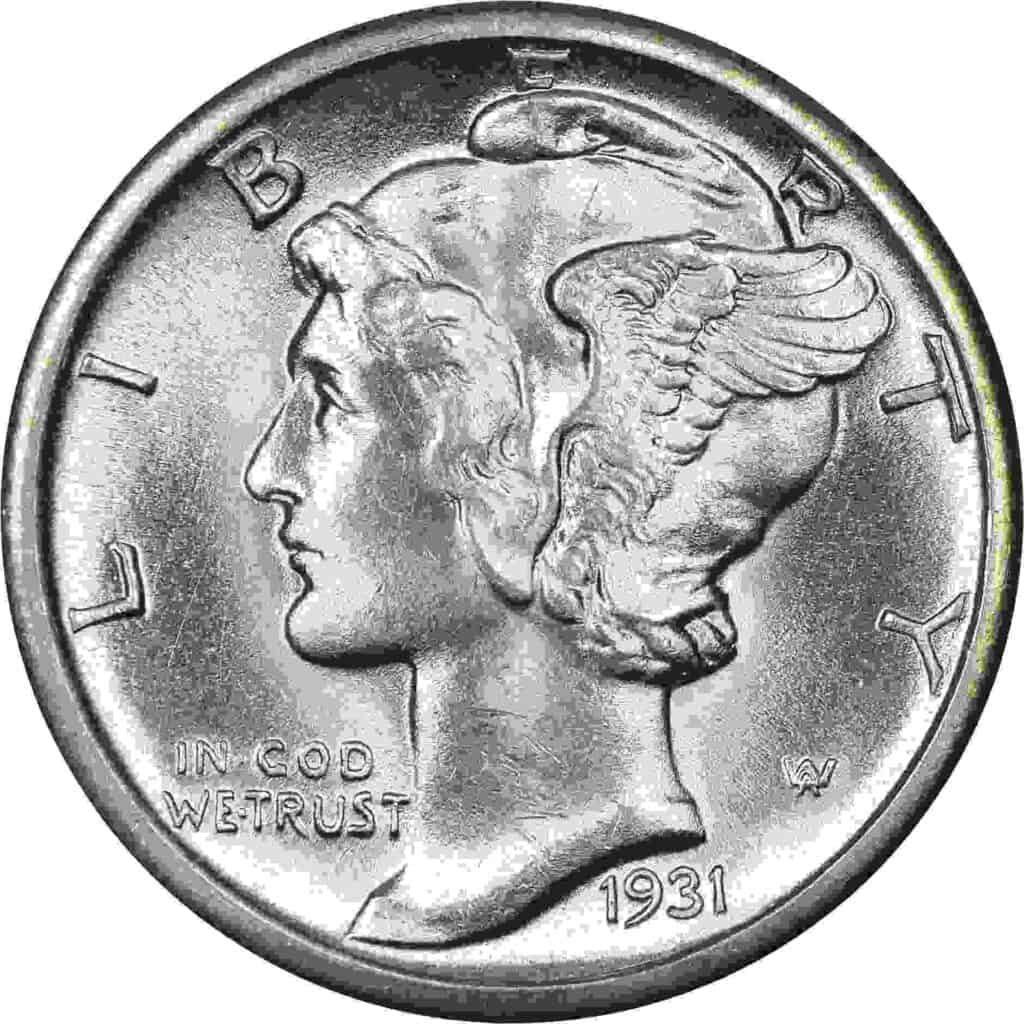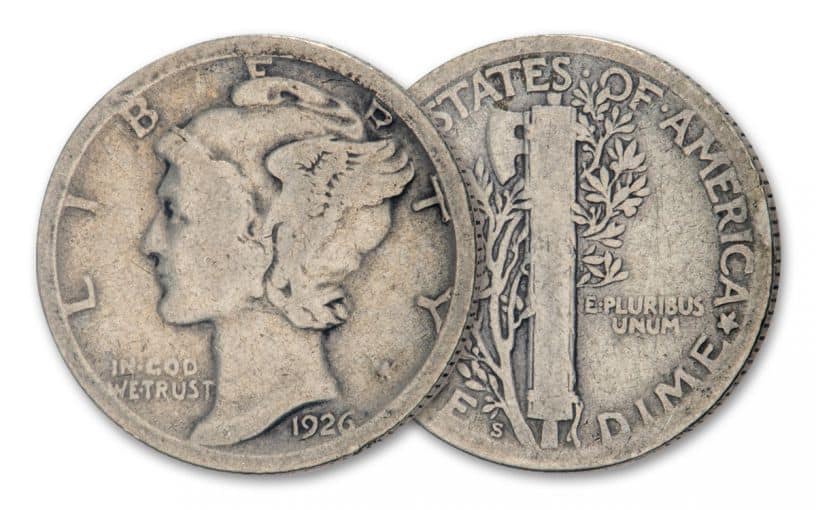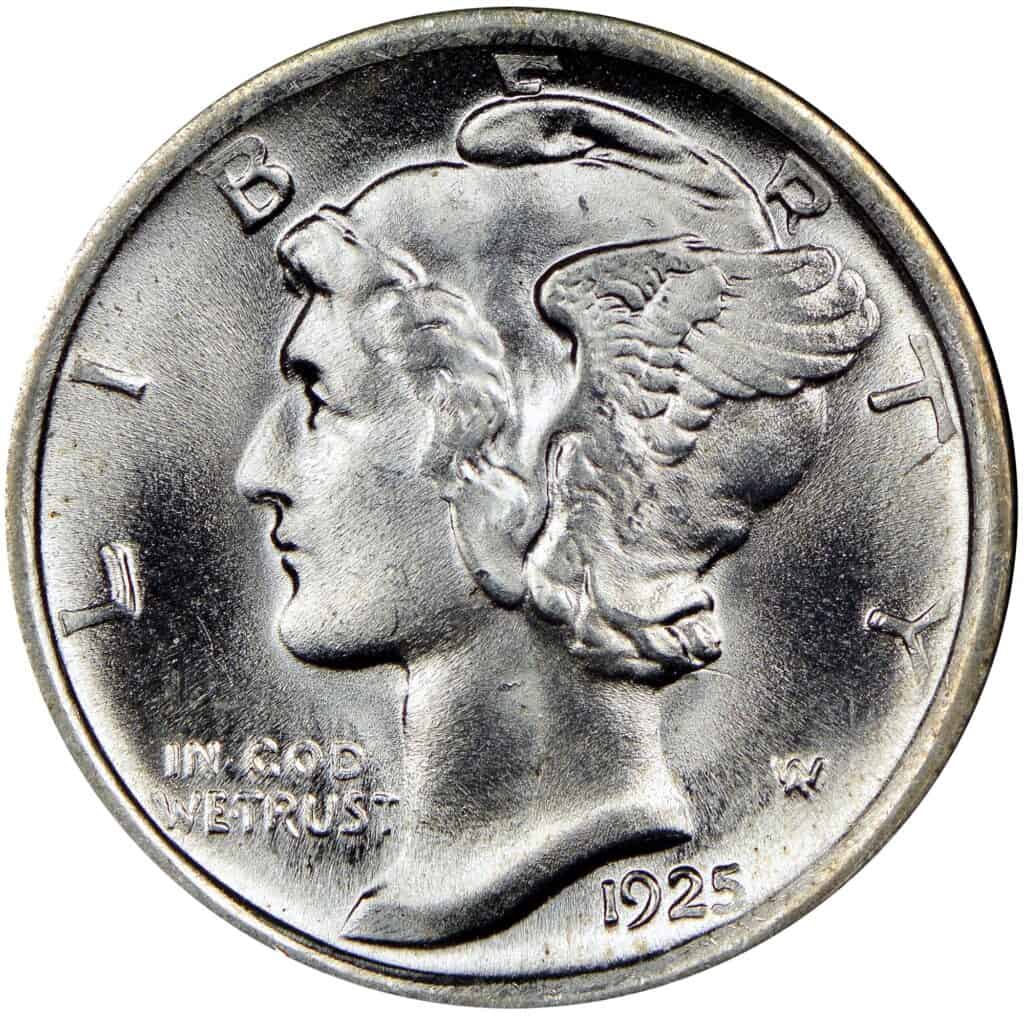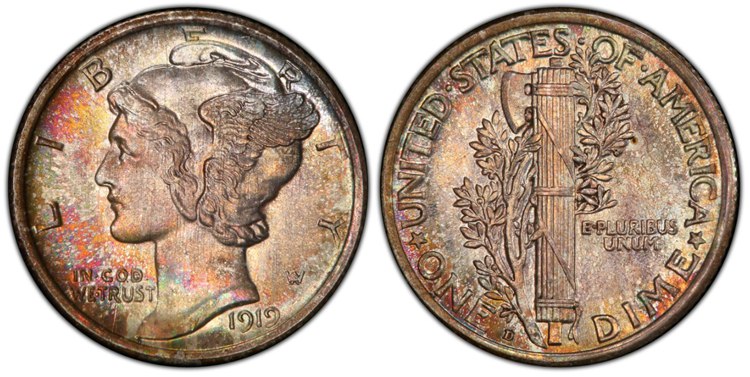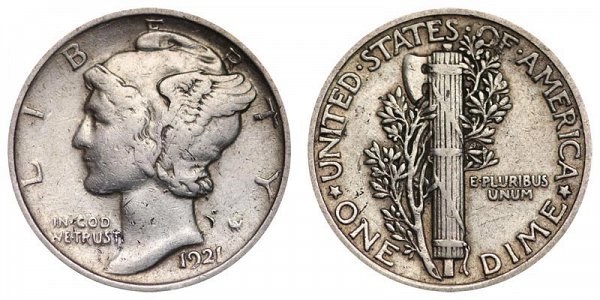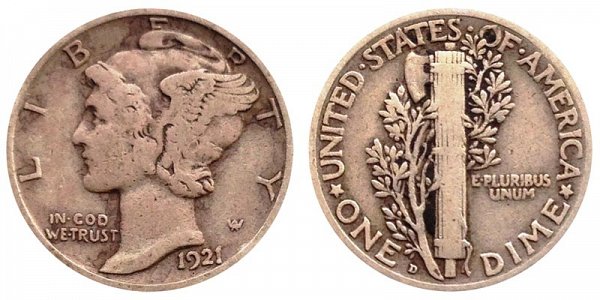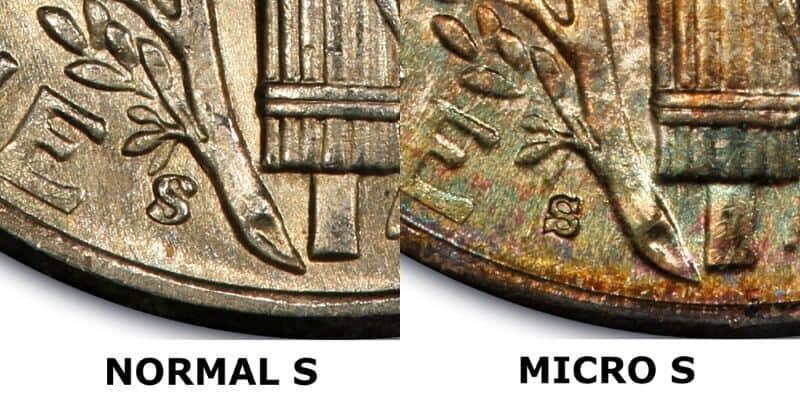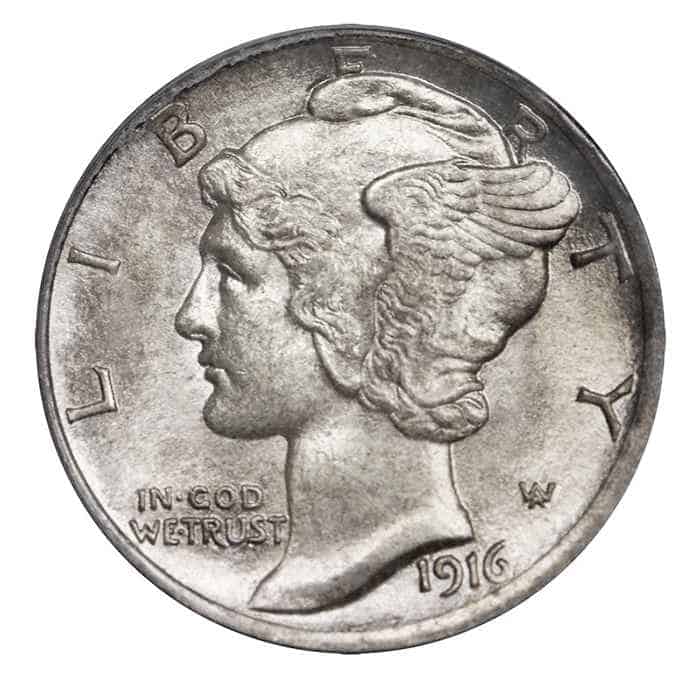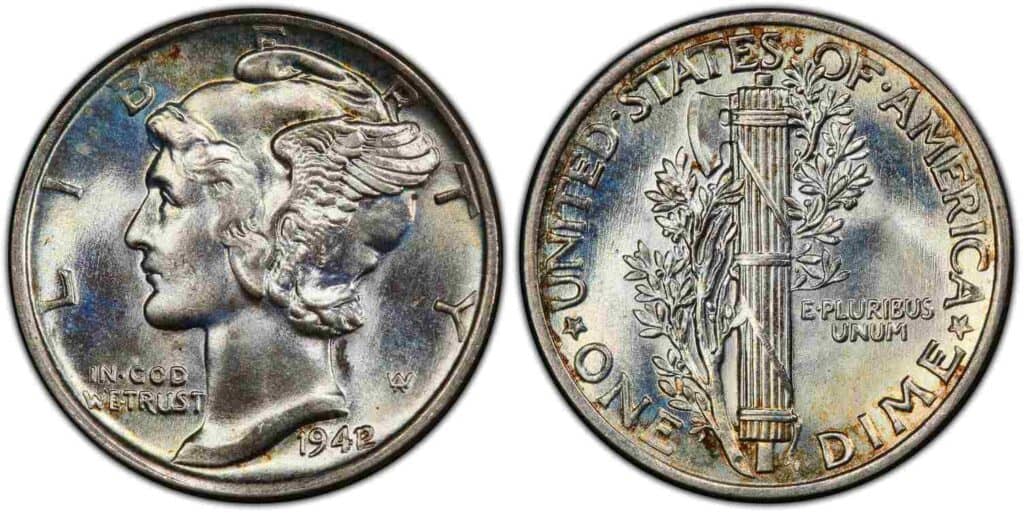The Mercury dime is often considered one of the most beautiful coins ever released by the US Mint. These ten-cent coins were produced between 1916 and 1945.
In 1916, the United States Mint held a competition among three sculptors to design new dime, quarter, and half-dollar. Sculptor Adolph Weinman’s design for dime and half-dollar was finalized.
The obverse of the dime features young Liberty with a winged Phrygian cap. Some confused it with the Roman god Mercury, hence the name. The other name that the coin goes by is Winged Liberty Head Dime.
Mercury dime is a popular item among coin collectors. Most of them are easily available as they were minted in large quantities, although finding them in Mint State can be difficult. However, some Mercury dimes are considered rare and valuable. Here we list 8 rare Mercury dimes that you should look out for.
8. 1931 D Mercury Dime
Mintage: 1, 260, 000
Year: 1931
Mint: Denver

photo source: amazonaws.com
Among the Mercury dimes that were produced in 1931, the ones stuck in the Denver Mint are the rarest. The scarcity is mainly due to the low mintage. This coin had the fourth lowest mintage in the entire Mercury dime series.
However, the coin is not as rare as it should have been. Many collectors who were aware of the low mintage collected and preserved them. As a result, it is relatively easy to find this coin in Mint State or even in Gem conditions.
According to the NGC Price Guide, a 1931 Mercury Dime’s worth is between $4 and $85 when in circulated condition. On the open market, the 1931 D Mercury dimes in uncirculated condition are sold for $875 or more.
Did you know?
1931 Mercury dime was the last issued dime before the suspension of production due to the Great Depression. The production was resumed again in 1934.
7. 1926 S Mercury Dime
Mintage: 1,520,000
Year: 1926
Mint: San Francisco

photo source: cdn-fsly.yottaa.net
The mintage of the 1926 Mercury dime stuck in San Francisco Mint was significantly low compared to many other coins in this series. The coin is considered quite rare and highly sought after by collectors.
The coin was released in 1926, the same year when the legendary “Route 66”- the Main Street of America was commissioned. Thus, this coin is nicknamed the “Route 66 Mercury Dime”.
Today, it is extremely challenging to find a 1926 S Mercury dime in good condition. There are only a couple of hundred examples of this coin that is graded MS65 or above.
Did you know?
In April 1945, after the death of President Franklin Roosevelt, the US Treasury decided to produce coins with his image to pay homage. Dime was chosen for this purpose for two reasons.
First, the earlier Mercury dime design was continued for more than 25 years, and thus, the Treasury didn’t need congressional approval to change the design.
The second reason was Roosevelt was a founder member of a non-profit organization called the March of Dimes. However, it is pertinent to mention that the organization had nothing to do with dimes.
6. 1925 D Mercury Dime
Mintage: 5, 117,000
Year: 1925
Mint: Denver

photo source: amazonaws.com
1925-D coins were softly struck. It is more evident in the designs on the peripheries. Some coins show weakness at the center, as well, while the peripheral letterings are extremely weak.
The mintage of this coin was relatively low, and surviving examples are scarce in all grades. It is not easy to find even heavily worn-out coins; Fine graded are even rarer. Mint State and gems are almost impossible to find.
This coin is highly sought after by coin collectors and can fetch a good amount of money when in uncirculated conditions.
NGC Price Guide sets the price of a 1925-D Mercury dime in circulated condition between $8 and $350. However, on the open market, the coin in uncirculated condition was sold for $2750.
Did you know?
After the Mercury dime was released on October 30, 1916, The New York Times, along with many other leading newspapers, complained that the monogram on the obverse was too prominent. They also suggested that the Treasury was considering withdrawing the design.
However, when Weinman got in touch with the Mint, he was reassured that the Treasury didn’t have such plans.
5. 1919-D Mercury Dime
Mintage: 9,939,000 pieces
Year: 1919
Mint: Denver

photo source: www.jacquelinestallone.com
1919-D Mercury dimes are not rare in circulated conditions. However, it is extremely rare to find examples in Mint State or graded MS66 or above. Most of the surviving examples of this coin are fully split or have poorly rounded crossbands.
It is primarily because a small number of well-struck coins were issued. Thus, it is challenging to find a Full-bands example of this coin.
While the price of an average condition 1919-D Mercury is around $4.00, a mint state condition could be sold at as high as $25,000 at suctions.
Did you know?
It was never revealed who was the model for the winged Liberty. However, many believe it was based on a sculpture of Elsie Steven, wife of American modernist poet Wallace Stevens.
4. 1921 and 1921-D Mercury Dime
Mintage: 1, 230,000 and 1,080,000, respectively
Year: 1921
Mint: Philadelphia and Denver, respectively

photo source: www.usacoinbook.com

photo source: www.usacoinbook.com
Both 1921 and 1921-D Mercury dimes are considerably scarce, mainly due to the low mintage. The 1921-D Mercury dime has the second lowest mintage in the entire series, and the 1921 variety has the third lowest mintage.
A mild recession that hit the American economy at that time led to the low mintage. Also, during this time, the Treasury prioritized the production of new silver dollars: Morgans and Peace.
Only a very few examples of these two coins still exist, and most of them are not in collectible condition.
Did you know?
Date and mintmark coin collections did not become popular until the 1930s and 40s. By that time, most 1921 and 1921-D Mercury dimes were either lost or worn out.
3. 1945-S Mercury Dime- Micro S Full Band
Mintage: Not known
Year: 1945
Mint: San Francisco

photo source: pcgs.com
1945-S Micro S is a popular collectible of this series. The S mintmark on the Micro-S variety is comparatively tinier than those on the regular 1945-S Mercury dime. A total of 41920000 pieces of 1945-S Mercury dime were struck. However, it is not known how many of them were of the Micro S variety.
According to Professional Coin Grading Service (PCGS) Population Report, more than 33% of the total dimes they received have a smaller mint mark. Of them, around 12% feature Full Bands.
Did you know?
The coins of the Micro S variety also feature sharper-edged serifs, whereas, on the regular 1945-S, the serifs are more rounded.
2. 1916-D Mercury Dime
Mintage: 264,000 pieces
Year: 1916
Mint: Denver

photo source: coinweek.com
1916-D Mercury dime is the key date of the series with the lowest mintage. Only 1,264,000 pieces of this coin were issued. In November 1916, the three mints were directed to strike quarters in a large number. Denver mint was instructed to suspend the production of a dime and make only quarters until the target was made. This makes Denver mint struck 1916 Mercury dime so rare.
NCG Price Guide suggests the price of a 1916-D Mercury dime in circulated condition should be between $850 and $12650. However, in the open market, the coin sells at a much higher price. A 1916-D Mercury Dime in uncirculated condition can be sold for $39000 or more.
Did you know?
1917-D Mercury Dime is also relatively rare because the mintage of dime at Denver mint was resumed only sometime during the middle of the year. Only 9,402,000 pieces of this coin were issued.
1. 1942/1 Mercury Dime Full Band
Mintage: Not known
Year: 1942
Mint: Philadelphia

photo source: pcgs.com
1942/1 Mercury Dime Full Band is the rarest mercury dime ever. It is essentially an error coin, generally termed as ‘overdate’. It is a doubled die error where the obverse die took impression from two dated hubs- 1942 and 1941.
The error is clearly visible to the naked eye. The 1 of 41 can be seen next to the 2 in 42. Also, the 4 shows signs of doubling. This error is one of the most well-known errors in the Mercury dime series.
The coins were probably struck in late 1941 when the 1942 dies were being prepared. A similar error happened to the 1942/1 D Mercury dime, but it was less visible.
A total of 205410000 pieces of 1942 Mercury dime were struck. This is the second highest number of coins to be produced in the entire series.
How many of these coins had the error is not known. A couple of thousand specimens have been graded, but most are in poor condition.
Uncirculated coins with Full Bands details are rare to find. Fewer than 300 coins are graded MS60 or better, and only a few dozen are graded M65 or higher.
Did you know?
Until the 1990s, two strikes were required for the dies so that the design could be fully impressed.

